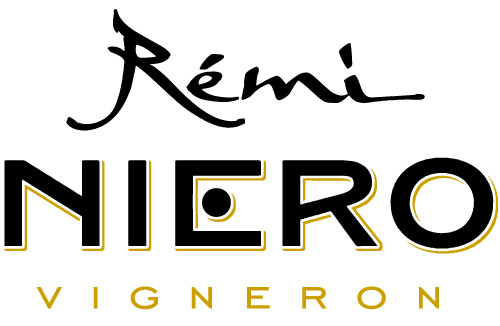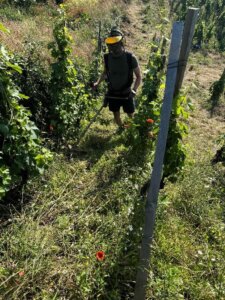During the summer, the vines are at an advanced stage of growth, and cultivation work is mainly aimed at maintaining the vines, preventing disease and promoting optimal development of the grape bunches. Here are the main cultivation operations we carried out over the summer:
-
Tillage: Begun in spring, tillage remains essential throughout the summer to keep the vines in a satisfactory state of health. The wetter the weather, the more intensive the tillage, due to the rapid regrowth of vegetation.
-

- Attachage Travaux d’été Domaine Niero condrieur côte rotie saint joseph Crozes Hermitage
-

- Tonte Travaux d’été Domaine Niero condrieur côte rotie saint joseph Crozes Hermitage
Grassing with clover or sedum under the row, ploughing with a rotovator, hoe and pickaxe. The soil is worked to prevent undesirable plants from competing with the vines or bringing disease.
-
L’ébourgeonnage” or “épamprage”: viticultural operation consisting in eliminating unwanted shoots that form along the vine shoots during the growing season. These shoots, called “gourmands” or “lateral buds”, generally grow from the nodes between the leaves and the bunches of grapes.
-
Raising the wires: The wires of the trellising system are raised to keep the shoots at an optimal height, promoting air circulation and protection against disease.
-
Tying: We tie the rods that have grown on the stakes, the aim being to hold them upwards, to sanitize and ensure the best possible photosynthesis.
-
Disease and pest control : Vines are regularly inspected for signs of diseases such as mildew, powdery mildew and other phytosanitary problems. Phytosanitary treatments can be applied if necessary to protect the vines.
-
Leaf thinning: Leaf thinning consists of deliberately removing certain leaves from the vine’s foliage to improve aeration and exposure of the bunches to the sun. This promotes uniform ripening of the grapes and helps prevent disease by reducing humidity and canopy density.
-
Topping: Young stems growing beyond the trellised wires and stiles are cut off. The aim is to concentrate photosynthesis at a controlled height.






Add comment
You must be logged in to post a comment.